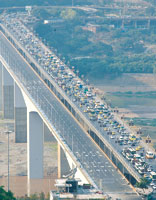 Photo: Huang He
|
| Chongqing is rapidly developing, and growth means increased traffic for its bridges. |
China’s tremendous infrastructure buildout is making it a country of superlatives and that includes bridge construction. From ring roads to signature crossings—particularly self-anchored suspension spans—bridge projects abound. Non-Chinese consultants and suppliers see a growing role for themselves in helping build these bridges to international standards—and one U.S. firm is staking its claim in a particularly bridge-rich section of China.
The hilly region of Chongqing in central China is a poster board for the kind of bridge construction flourishing in the country. With the Yangtze and Jia-ling rivers running through it, some 20 new bridges are planned in the next decade. and three “superlative” bridges are under way or nearing complete now. “It’s the Pittsburgh of China,” says Tom Ho, vice president of San Francisco-based T.Y. Lin International (TYLI).
Its Chongqing office has grown from five to more than 100 staffers in the past five years as the firm found less competition there than other regions. The firm now reports 25% of its total revenue comes from China work. T.Y. Lin International reported $111.1 million in total design revenue for 2005, placing 83 on ENR’s list of Top 500 Design Firms (ENR 4/25 p. 44)
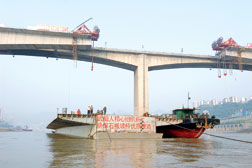 Photo: Huang He |
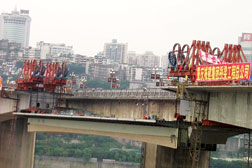 Photo: Dorman Long Technology
|
| English subcontractor erected record-breaking 330-m-long box girder span over the Yangtze River in Chongqing. |
TYLI’s Chongqing and U.S. offices designed the $45-million Shibanpo Bridge in the heart of Chongqing city. It includes what officials say is the world’s longest box girder main span, at 330 meters. The new 1,103.5-m-long, seven-span box girder bridge will provide a navigation clearance of 300 m over the rising Yangtze. The main span incorporates a central 108-m-long steel box section combined with prestressed concrete box girders to decrease weight, says David Dyer, managing director for Dorman Long Technology. The U.K.-based firm provided erection services for the bridge. “We foresee an expanding business in [the Chinese] market for at least the next eight to ten years,” he says.
The steel box section was fabricated in Wuchang, some 1,000 kilometers downstream, and towed upstream as a 1,325-tonne center section and two 100-tonne end segments. Upon arrival at the bridge site this March, the three sections were turned 90° by cables on both sides of the river and lifted into place using strand jacks supported on temporary frames.
Work on Shibanpo began in December 2003 and is nearly ready to carry 20,000 daily motorists, says Deng Yu, a TYLI engineer. It will relieve traffic on the 25-year-old concrete girder span alongside it, which is becoming more congested as 12 million rural residents migrate into the city, according to government statistics.
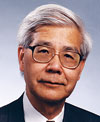 | "Now we may be able to learn from the Chinese [in building bridges]." - Man-Chung Tang, T.Y.Lin Int�l Chairman |
Just 1.5 km downstream is another “superlative” bridge, which crews began building at the same time as Shibanpo Bridge. The $190-million Caiyunba Bridge will be the world’s longest tied-arch span carrying both rail and highway traffic when it is completed a year from now, says TYLI Chairman Man-Chung Tang, whose firm designed the tied arch in a joint venture with Chongqing Communications Research Institute.
The choice of a slender tied-arch design, including steel boxes forming the arch above the deck, is influenced by the aesthetic desires of city officials. This is typical in China, notes David Tsui, Hong Kong-based senior engineering manager with Parsons Brinckerhoff, New York City. “There are many non-technical influences to bridge design, such as the preferences of the mayor,” he says.
The cable-supported 420-m-long tied Caiyunba arch span will allow for a 392-m navigation clearance. It will support six lanes of highway on the upper deck and two lanes for a monorail on the lower deck. The piers, approach spans and below-deck portions of the bridge are concrete. An 11-m-deep truss provides clearance for the monorail and is continuous over five spans, reaching the 102-m-long end spans without vertical strut supports. Overhead lines hanging from temporary towers aid in lifting 800 m of steel girders into place.
TYLI also is designing the asymmetrical cable-stayed Second Wujiang Bridge, located in Fulin about 100 km east of Chongqing. Fulin is developing rapidly as people displaced by the Three Gorges Dam project resettle there.
The 8th Construction Co. of Zhongtie is completing foundation work during the low-water months between November and May. The foundations will eventually be under water once Three Gorges’ fully filled reservoir increases water levels by about 40 m. With steep slopes on either side, the pair of single pole towers are 105.4 m and 66.4 m, respectively, above the 25.5-m-wide deck. Their total height is 129 m and 178 m. They support a 340-m-long prestressed concrete main span and side spans of 150 m and 100 m. Those lengths are shorter than ideal, “but local conditions do not allow for a better arrangement,” says Tang. The north end connects to a dizzying three-level spiral ramp with a 45-m radius.
In 2000 TYLI obtained a permanent Class A bridge design license in China, which allows it to do actual design on bridges over 60 m in length. Tang believes it is one of the first overseas firms to obtain the license, which came after building a track record of design reviews, consulting and joint venture work. Parsons Brinckerhoff expects to obtain one by next year. Michael Yu, a project director for U.K-based Halcrow Group, says it is not planning to gain a Class A license for design and will opt to continue pursuing consultant work on big Chinese projects. “With a license, you have to have a full local staff,” he notes.
The influence of TYLI and others is helping China build structures with higher design quality than in the past. For example, TYLI introduced Chemco Systems, Redwood City, Calif., to Chinese engineers in 2000 to provide epoxy asphalt paving for the Nanjing Second Yangtze River Bridge. “For long-span steel deck projects previously completed in China, there was already a growing recognition of pavement performance issues,” says John Bors, vice president of Chemco. Bridges in China often don’t have weight limit enforcement, and temperatures of bridge decks can reach 160°F in the Yangtze delta, leading to delamination of softened pavements, he says. Epoxy asphalt acts compositely with the deck to reduce deflection, and doesn’t melt or soften.
 |
The material is now being applied on several bridges. “We are cooperating with universities in both China and the U.S. to test future deck paving systems,” says Bors. “Chinese demand for our product has increased.”
Another new bridge to specify epoxy asphalt is the 750-m-long Nanhuan crossing in Changping, near Beijing. The bridge is part of a 2,788-m-long new road that will connect Changping with a new town across the Dongsha River. The $32-million crossing is a three-span self-anchored suspension (SAS) bridge with twin cable planes and a 316-m-long main span, supported by concrete pylons. Beijing Municipal Engineering Design Institute began design in January 2006. Beijing Municipal Construction Co. and Jiangyin Construction began work in November 2005 and the bridge will open by year’s end.
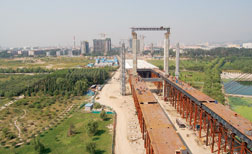 Photo: Leslie Jenkins |
 Image: T.Y. Lin Int'l
|
| Nanhuan Bridge is one of several self-anchored suspension bridges being built in China, says TYLI�s Ho (far right below). |
Ho notes that the bridge is reminiscent of the California Dept. of Transportation’s $6-billion Oakland-Francisco Bay Bridge. “One difference is that this has twin towers whereas the Bay Bridge has only one,” he says.
Quin Zhi Kai, supervision engineer for owner Beijing Mingja Real Estate Development Co., says using an SAS design was “aesthetically exciting” and reduced anchorage block concrete from 3,000 cu yd to 1,000 cu yd. The deck is placed in 24-m-long sections, supported on falsework. A 5,000-acre lake will be created beneath the bridge next year.
SAS bridges have been built in China before, but they weren’t long spans. Ho notes that six major SAS spans are being built in China now.
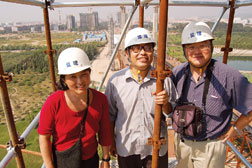 Photo: Leslie Jenkins
|
“They may be inspired by the Bay Bridge,” he says. Adds Tang: “The Chinese thought they’d learn from the Bay Bridge construction. Now we may be able to learn from them.”
Caltrans spokesman Bart Ney confirmed that two Caltrans managers did “visit sites of recently constructed bridges, primarily to determine if we should send key staff to observe them.” But he says, “We are not ready to discuss design differences between SAS spans in China and the one we will build.”
TYLI also performed design and construction review for the $55-million, 680-m-long Pingsheng Bridge, due to open next month. It claims the world’s longest SAS span, at 350 m, until the Bay Bridge’s 385-m-long span is built.
Located in Foshan near Guangzhou, the bridge uses a steel orthotropic twin box girder with prestressed concrete box girders to comprise the 224-m back span. Four main suspension cables support the incrementally launched box girders, with 27 sets of hangers spaced 12 m apart. A 145-m-tall pylon separates the SAS span from the back span, which is supported on piers and has no hangers. Technically, the bridge is “half a suspension bridge,” says Ho.

Post a comment to this article
Report Abusive Comment